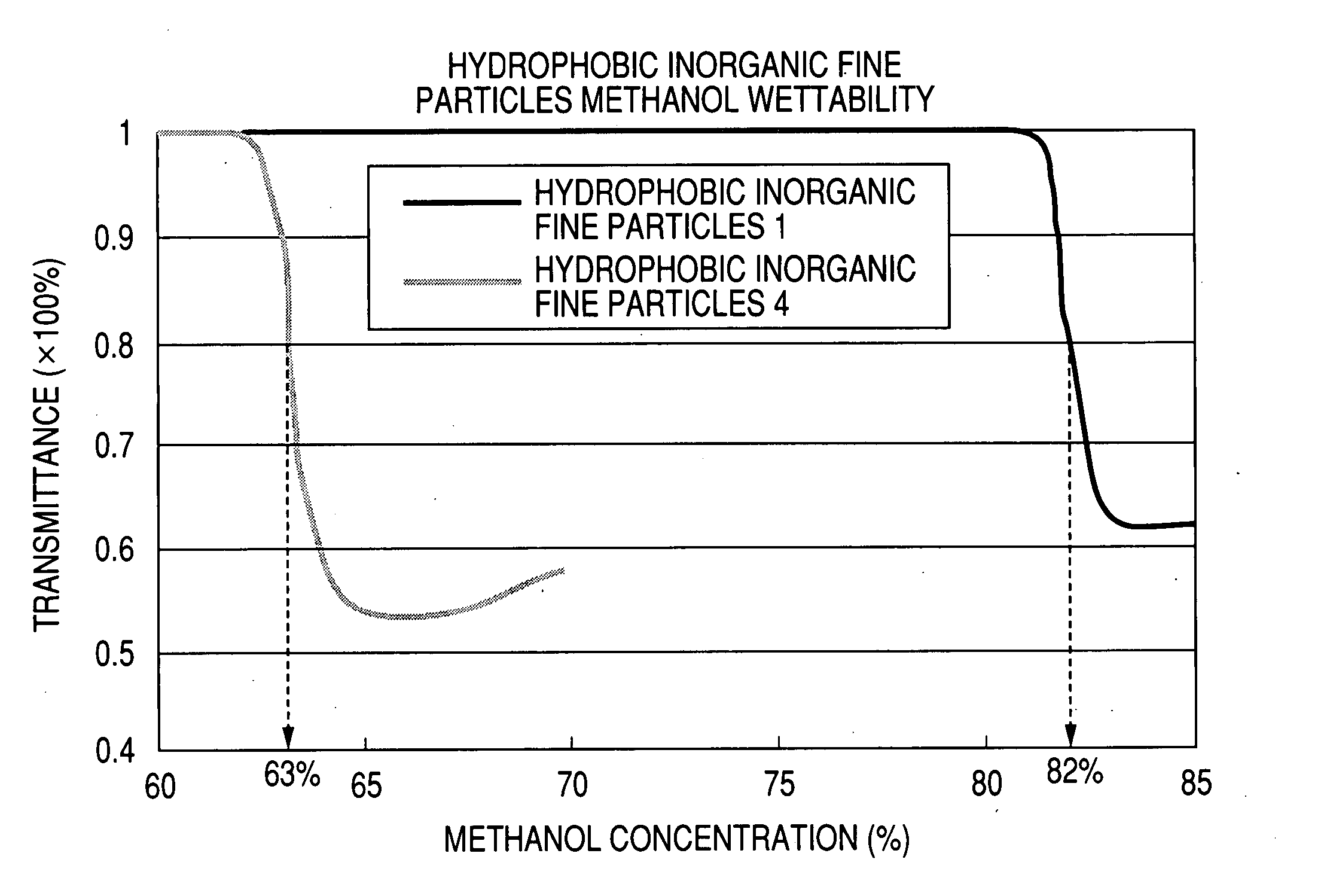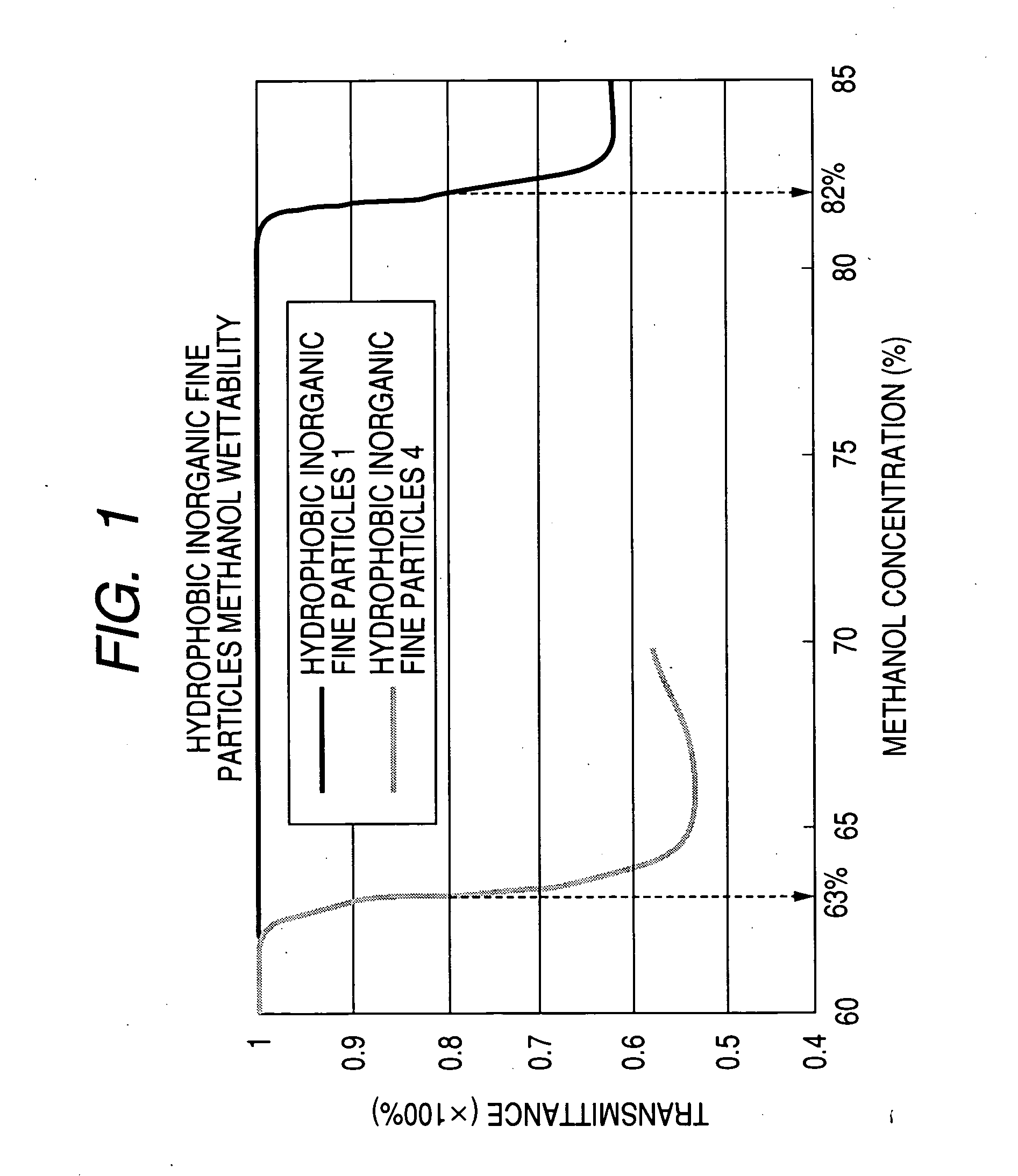Hydrophobic inorganic fine particles, hydrophobic inorganic fine particles production process, and toner
a technology of hydrophobic inorganic fine particles and production process, which is applied in the direction of instruments, cellulosic plastic layered products, natural mineral layered products, etc., can solve the problems of fluidity and chargeability, insufficient development durability and charging stability, and difficulty in uniform dispersing of both on the surface of toner particles, so as to achieve superior fluidity, chargeability and durability (running performance) of toner
- Summary
- Abstract
- Description
- Claims
- Application Information
AI Technical Summary
Benefits of technology
Problems solved by technology
Method used
Image
Examples
production examples 2 to 16
Hydrophobic Inorganic Fine Particles 2 to 16 were prepared in the same manner as in Hydrophobic Inorganic Fine Particles Production Example 1 except that the inorganic fine particles and the surface treatment agent were changed as shown in Table 1.
Binder Resin
production example 1
50 parts by weight of a propylene oxide 2-mole addition product of bisphenol A represented by the following formula (A) (R represents a propylene group, and the average value of x+y is 2):
20 parts by weight of an ethylene oxide 2-mole addition product of bisphenol A represented by the above formula (A) (R represents an ethylene group, and the average value of x+y is 2), 20 parts by weight of terephthalic acid, 5 parts by weight of fumaric acid, 5 parts by weight of trimellitic anhydride and 0.5 part by weight of dibutyltin oxide were put into a reactor, and these were subjected to condensation polymerization at 220° C. to obtain Binder Resin 1 of polyester. This resin had a main-peak molecular weight of 8,300, a weight-average molecular weight (Mw) of 680,000, an acid value of 24 mg·KOH / g. a Tg of 59° C. and a THF-insoluble matter of 21% by weight.
Binder Resin
production example 2
300 parts by weight of xylene was introduced into a four-necked flask, and then heated and refluxed, where a liquid mixture of 75 parts by weight of styrene, 25 parts by weight of n-butyl acrylate and 2 parts of di-tert-butyl peroxide was dropwise added over a period of 5 hours to obtain a low-molecular weight polymer (L-1) solution. L-1 had a peak molecular weight of 12,000 and a weight-average molecular weight (Mw) of 15,400.
180 parts by weight of deaerated water and 20 parts by weight of a 2% by weight aqueous solution of polyvinyl alcohol were introduced into a four-necked flask, and thereafter a liquid mixture of 70 parts by weight of styrene, 30 parts by weight of n-butyl acrylate, 0.005 part by weight of divinylbenzene and 0.1 part by weight of 2,2-bis(4,4-di-tert-butylperoxycyclohexyl)propane (half-life 10-hour temperature: 92° C.) was added thereto, followed by stirring to prepare a suspension. The inside of the flask was sufficiently displaced with nitrogen gas, and the...
PUM
| Property | Measurement | Unit |
|---|---|---|
| particle diameter | aaaaa | aaaaa |
| particle diameter | aaaaa | aaaaa |
| BET specific surface area | aaaaa | aaaaa |
Abstract
Description
Claims
Application Information
 Login to View More
Login to View More - R&D
- Intellectual Property
- Life Sciences
- Materials
- Tech Scout
- Unparalleled Data Quality
- Higher Quality Content
- 60% Fewer Hallucinations
Browse by: Latest US Patents, China's latest patents, Technical Efficacy Thesaurus, Application Domain, Technology Topic, Popular Technical Reports.
© 2025 PatSnap. All rights reserved.Legal|Privacy policy|Modern Slavery Act Transparency Statement|Sitemap|About US| Contact US: help@patsnap.com



